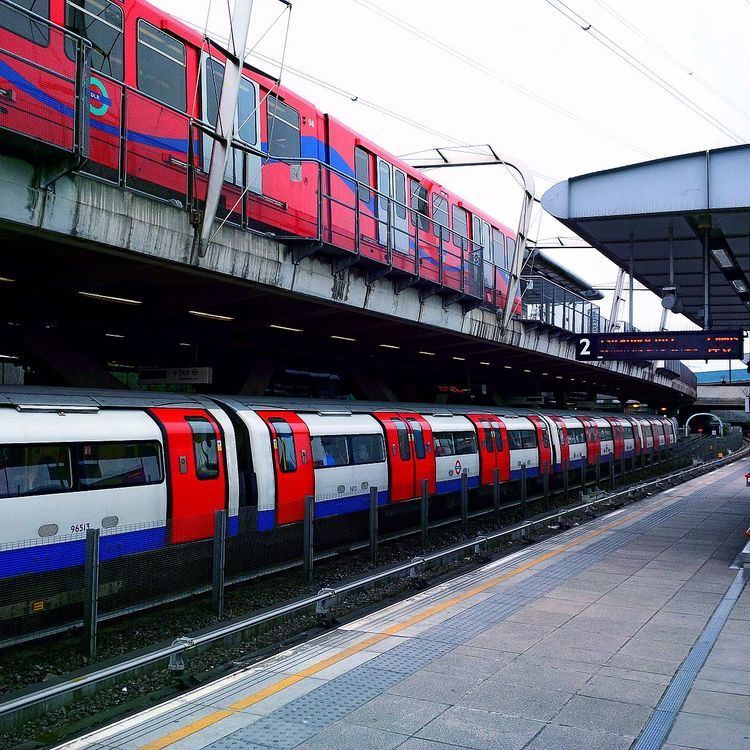Accessible Yes 2012 8.74 million Opened 14 June 1847 | Fare zone 2 and 3 2013 9.78 million Number of platforms 6 | |
 | ||
Similar London Underground, Custom House for ExCeL D, North Greenwich tube station, London City Airport DLR stati, East India DLR station | ||
A ride on the number 5 bus from romford station to canning town station london
Canning Town is an intermodal interchange station in Canning Town, East London. It is served by the London Underground Jubilee line, the Docklands Light Railway (DLR) and local buses operated for London Buses. On 11 November 2015 the Mayor of London announced that it would be rezoned to be on the boundary of Travelcard Zone 2 and Travelcard Zone 3. Until 1873 it was known as Barking Road.
Contents
- A ride on the number 5 bus from romford station to canning town station london
- Dlr canning town station first day sevice to stratford internation pt6 wed 31 aug 2011
- History
- Design
- Location
- London Underground
- Docklands Light Railway
- London Buses
- References
Dlr canning town station first day sevice to stratford internation pt6 wed 31 aug 2011
History
The first station, originally named Barking Road, was opened on 14 June 1847 by the Eastern Counties and Thames Junction Railway on the south side of Barking Road in the Parish of West Ham. It was renamed Canning Town on 1 July 1873, and in 1888, this station was closed, being replaced by a new station on the north side of Barking Road (near Stephenson Street). The booking hall was replaced in the 1960s, and survived until 28 May 1994. On 29 October 1995, a new North London Line station on the current site was opened. Original DLR plans were that the Beckton line would run directly east/west between Blackwall and Royal Victoria, and the substantial loop to serve Canning Town was a late design change. The DLR station opened on 28 March 1994, but was closed between 6 June 1996 and 5 March 1998 for the construction of the Jubilee line extension. The Jubilee line station opened on 14 May 1999. The North London Line platforms closed on 9 December 2006 as part of the closure of the Stratford to North Woolwich section of the line. On 31 August 2011 these platforms re-opened on the new Stratford International branch of the Docklands Light Railway.
On the station is a plaque commemorating the Thames Iron Works, which stood on this site.
Design
The station is connected by an underground concourse stretching the width of the site and connected to all platforms and the bus station by escalators, stairs and lifts.
To the west of the complex two island platforms are one above the other. The lower platform is served by the Jubilee line (1 platform two faces) and the higher the DLR. To the east of the Jubilee platforms on the same level one platform (two faces) is served by the DLR (these were served by the North London Line until 9 December 2006 and reopened for DLR on 31 August 2011). The bus station has an enclosed above-ground concourse with doors to the surrounding bus bays.
The DLR branch to London City Airport opened on 2 December 2005. This branch diverges from the branch to Beckton 1/4 mile south of the interchange, with trains from both branches serving the current platforms. The next station along the branch is West Silvertown. A substantial change to the DLR junction south of the station opened on 1 June 2009, when the Beckton branch was diverted onto a new flyover that crosses the eastbound Woolwich branch and the branch to Stratford International. As a result of these changes trains to Woolwich and Beckton can depart from any DLR platform face.
The bus station area is on the eastern side of the interchange fully connected to the DLR and Underground platforms via a subway providing links right across East London.
Location
The interchange is on a north-south alignment, constrained by Bow Creek immediately to the west, Silvertown Way to the east, the A13 Canning Town Flyover (a major east-west road bridge crossing the Canning Town Roundabout at the throat of the station) to the north, and the River Thames to the south.
London Underground
The typical off-peak service, in trains per hour (tph) is:
Night Tube services run every 10 minutes on the entire line on Friday and Saturday nights.
Docklands Light Railway
The typical off-peak service is; in trains per hour (tph) is:
In the peak hours the pattern is:
London Buses
London Buses routes 5, 69, 115, 147, 241, 300, 309, 323, 330 and 474 and night routes N15, N550 and N551 serve the station.
